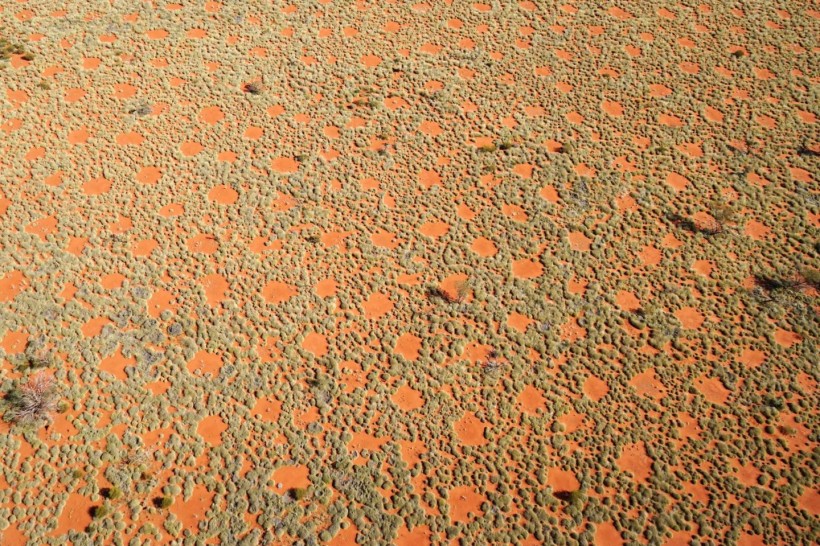For over half a century, scientists have pondered the origins of Namibia's fairy rings. It came down to two primary theories: termites were to blame, or plants were self-organizing. The grasses within the fairy rings perished shortly after rainfall, as per scientists from the University of Göttingen, who took advantage of two extremely strong temperature and precipitation seasons in the Namib Desert.
However, termite activity did not produce barren patches. Instead, constant soil-moisture measurements show that the grasslands around the circles exhausted the moisture within the circles, possibly causing the crops inside the circles to die. Perspectives in Plant Ecology, Evolution, and Systematics is the journal where the findings were published.
Millions of fairy rings may be discovered within Namib, approximately 80 and 140 kilometers from shore. These round holes in the grassland are a few meters wide, and together they form a recognized shape that can be seen for miles around. The scientists examined grasslands, their roots, shoots, and possible termite root damage during periodic rain occurrences in several arid locales.
Uncovered Mythical Mysteries
Termites, microscopic insects that exist in enormous colonies all over the world, have frequently been blamed for grass dying. The study measured great effort to analyze the characteristics of dying plants within fairy rings just after the rainstorm, which prompted the fresh development of the grasses, as reported by SciTech Daily.
Furthermore, soil-moisture sensors were set within and around fairy circles to measure ground contents at 30-minute intervals from the summer months of 2020 through the conclusion of the monsoon season of 2022.
The scientists were able to carefully document how the development of the new emergent grasses all around the circles altered the soil moisture within and adjacent to the circles as a result of this. They studied the variations in water penetration between the outside and inside of circles in eleven Namib locations.
Based on the university news, the findings demonstrate that roughly ten days after precipitation, the grasses within the circles began to die, whereas the majority of the interior region of the circles had no grass reproduction at all. These struggling grasses inside the circles were fully dead and yellowish in hue twenty days after rains, while the neighboring grasses were essential and green.

Fairy circles are round gaps in arid grassland distributed uniformly over the landscape and only occur along the Namib Desert in southern Africa and parts of Australia. Various theories circulate about the actual cause of these unusual spatial patterns, ranging from poisonous Euphorbia plants or rising gases to ants, termites, or plant competition for sparse water resources.
Grasses Stem Within the Circles
When the researchers compared the stems of the grasses within the circles to the green grasslands on the outside, they discovered that the stems within the circles were as long as, if not longer than, those on the outside. This suggested that the grasslands were working hard to establish roots in quest of water. The researchers, however, discovered no signs of termites eating on roots. The root damage on the dead grasses was not obvious before fifty to sixty days, followed by a downpour.
According to Dr. Stephan Getzin of the University of Göttingen's Department of Ecosystem Modelling, the abrupt disappearance of grass in most locations within the rings cannot be explained by termite activity since there was no biomass for such insects to feast on. More significantly, scientists can demonstrate that termites are not to blame since the grasses die soon after rains with no trace of organisms nibbling on the root.
When the researchers examined the information on soil-moisture changes, they discovered that the reduction in soil water within and outside the rings was very modest after the initial rainstorm, when grasses had not yet formed.
Namib Temperatures
Getzin notes that due to the high temperatures in Namib, these same grasses are constantly currently happening and losing water. As a result, they produce soil-moisture hoovers around their roots, attracting water. The findings substantially support previous findings that moisture in soil diffuses swiftly and widely in these sands across distances larger than seven meters.
The grasses operate as part of the ecosystem and benefit directly from the water supply offered by the plant gaps by generating beautifully patterned landscapes of uniformly spaced fairy circles. They know similar self-organized vegetation patterns from various hard drylands throughout the world, and in all of those circumstances, the plants have no other option than to grow precisely in such geometrical forms.
This discovery has significance for understanding comparable ecosystems, particularly in light of climate change, because plant self-organization buffers against the deleterious consequences of rising aridification.
RELATED ARTICLE: Minishocks in Plants Due to Thunderstorms Can Affect Hydroxyl Radicals, Altering Air Quality
Check out more news and information on Environment in Science Times.














